Article
Holding on to Objects in Motion:
Two Māori Musical Instruments in the Peabody Essex Museum
Résumé
Deux flûtes maories du Peabody Essex Museum fournissent une vue à multiples facettes d’objets en mouvement. Ces flûtes, sculptées en Nouvelle-Zélande, ont été acquises par un capitaine de Salem au cours d’un voyage commercial et offertes au musée en 1807. Cet article suit le mouvement des flûtes dans le temps et l’espace, en suivant les circuits de la cosmogonie Maori, de la traite occidentale, des échanges interculturels, et du souffle et du son incarnés dans les flûtes. Il suggère que ces petits instruments soigneusement sculptés, qui exigent pour « jouer » un fort engagement et une importante concentration, ont leur propre logique de circulation et d’organisation du pouvoir, et se déplacent au travers de frontières temporelles et spatiales, de catégories et de niveaux musicaux, refusant de devenir de simples objets de musée statiques et sans vie.
Abstract
Two Māori flutes in the Peabody Essex Museum provide a multi-faceted view of objects in motion. The flutes, carved in New Zealand, were collected by a Salem captain during a trading voyage and donated to the museum in 1807. This paper follows the movements of the flutes across space and time, tracing the circuits of Māori cosmogony, Western trade, cross-cultural exchange, and breath and sound embodied in the flutes. The paper suggests that these small, carefully crafted instruments, requiring close engagement and focus in order to “play,” have their own logic of circulation and organizing power and move across temporal and spatial boundaries, categories and musical planes, refusing to become static, lifeless museum objects.
Herman Melville, Moby-Dick (2002 [1851]: 151)
1 The Oceanic collection of the Peabody Essex Museum in Salem, Massachusetts, is internationally recognized and celebrated for its unique, beautiful, and high-quality objects. Some of the earliest objects were collected by Salem mariners during trading voyages to China and the East Indies in the late 18th and early 19th centuries. In 1807, William Richardson, captain of the Eliza, gave a large group of Pacific artifacts to the East India Marine Society, as the Peabody Essex Museum was then known. The collection includes over twenty Māori artifacts and is one of the earliest and most significant groups of Māori objects donated to the Peabody (Wagelie 2007: 23).1 It contains a number of impressive objects, including a pare (door lintel), papahou (treasure box), and a shark-tooth knife, but two small flutes in the collection have caught and held my attention. These small, delicate instruments allow an exploration of objects in motion, from epic transnational voyages and early exchanges between Americans and Polynesians to careful, tiny movements between musician and instrument that encourage a closer entanglement between person and thing, here and there, and past and present (Fig. 1 and Fig. 2).
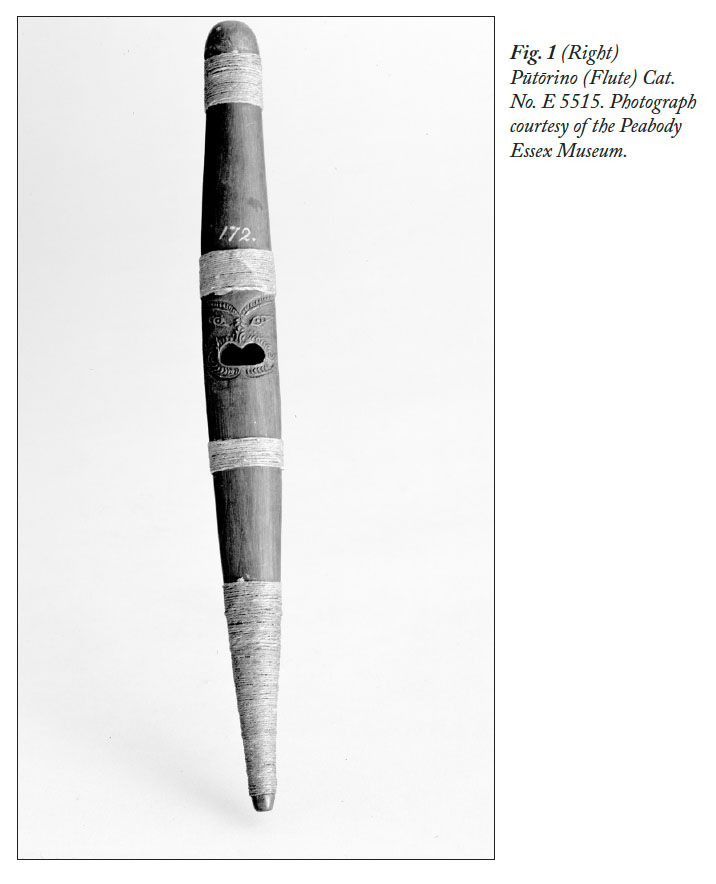 Display large image of Figure 1
Display large image of Figure 1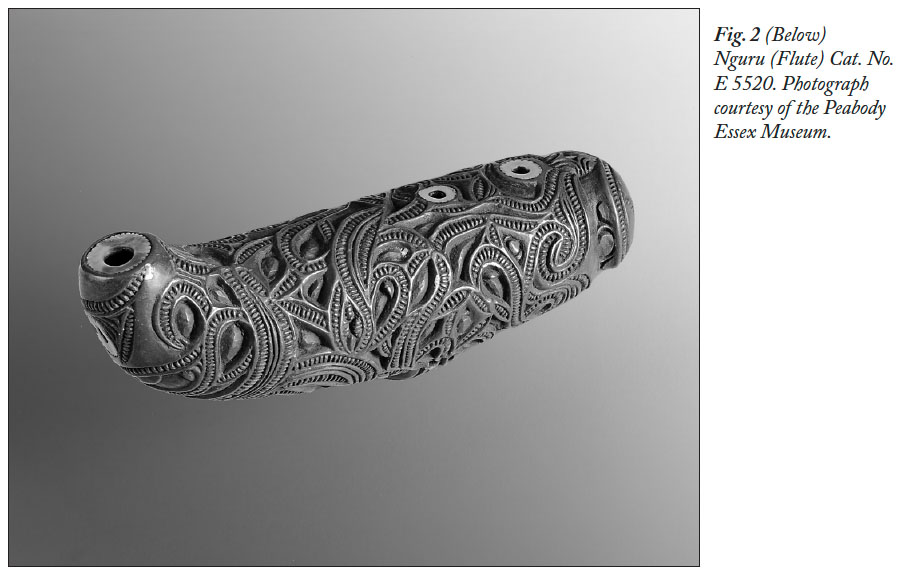 Display large image of Figure 2
Display large image of Figure 2Dispersion
2 When Captain William Richardson set sail on the Eliza in 1805, Salem was in the midst of a period of enormous prosperity (Copeland 1955). Following the American Revolutionary War (1775-1783), Salem merchants and seafarers had been among the first Americans to sail their large vessels around Cape Horn and the Cape of Good Hope and open up lucrative new trade routes with China and the East Indies (Copeland 1955; Phillips 1947: 31, 46). Their vessels left Salem with goods such as rum, tobacco, and clothing, and returned between one and two years later laden with sugar, coffee, pepper, porcelain, silks, and other luxury goods, which they sold within America or on to other markets. It was a hugely profitable, if risky, business.
3 From the late 18th century, some Salem traders began sailing through the Pacific, stopping at ports along the way to collect products in demand in China.2 They were part of a wave of European commercial vessels flowing into the Pacific following the scientific expeditions of Captain James Cook and others in the mid- to late 18th century. Initially, traders sought otter and seal skins in the Northwest and South Pacific, but once these had become depleted they began harvesting sandalwood and beche-de-mer (sea slugs) from Hawaii, Fiji, and other Pacific Islands (Dodge 1965: 24-25). These commercial voyages initiated a period of closer exchange between Europeans and Pacific Islanders, bringing people, things, and ideas from around the Pacific into contact with Europeans and with each other for the first time (Salmond 1997: 175).
4 Commercial voyages such as the Eliza’s were not well documented, and so it is difficult to assess the nature and legacy of exchanges between traders and Polynesians. In the case of the Eliza, primary evidence amounts to the incomplete logbook of a crew member, some family records and newspaper reports, compared with the multiple logbooks, journals, and other documentation kept during scientific expeditions such as Cook’s voyages, for example.3 Further, while we have some documentation, albeit limited, of the European version of events during the voyage of the Eliza, there are no written records of the Polynesian side of the story. The objects that Richardson collected are the only primary evidence of the Polynesian version of these exchanges.4 Historian and anthropologist Nicholas Thomas has suggested that one way of addressing poor documentation of museum artifacts could be to “work towards a theoretical framework that is empowered by the object we have – the artefact itself – rather than disempowered by what we lack – the contextual information” (1999: 7). By turning to the objects themselves, and exploring how they gather meaning as they move across space and time, we may gain further insight into the nature and repercussions of the early encounters of American traders in Polynesia.
Embodiment
5 Researchers believe that the New Zealand objects collected by Richardson originally came from the Bay of Islands, an area at the top of the North Island that was frequently visited by Europeans at the turn of the 19th century (Dodge 1941: 7; Brown 2003: 128). Deidre Brown has identified similarities between the carvings on Richardson’s objects and those on other carvings from the northern part of the North Island, known to Māori as Tai Tokerau (Northland, including Auckland and areas north; Brown 2003: 24, 106).5 Brown has noted that Richardson’s collection is the earliest dated and provenanced museum collection of carvings from this area and that artifacts such as these are regarded by Māori as taonga (treasures) (72).6
6 Like all taonga, or sacred things, each musical instrument was unique and possessed its own mana (spiritual power), mauri (life force), and wairua (spirit), as well as manifesting spiritual power and authority (Brown 2003: 218). When Marcel Mauss discussed the concept of taonga in his seminal text The Gift (1990 [1950]), he noted that taonga “are strongly linked to the person, the clan, and the earth” and described them as “the vehicle for its mana, its magical, religious, and spiritual force” (Mauss 1990 [1950]: 10-11).7 More recently, Anne Salmond has commented that “the alchemy of taonga [brings] about a fusion of men and ancestors and a collapse of distance in space-time.... The power of [such things can] give men absolute access to their ancestors” (Salmond quoted in Henare, Holbraad, and Wastell 2007: 57). Similarly, Amiria Henare has demonstrated that for Māori, taonga instantiate whole ancestral lineages; they are ancestral efficacy and power in specific form, rather than merely representing or carrying these concepts (Henare, Holbraad, and Wastell 2007: 56-57).
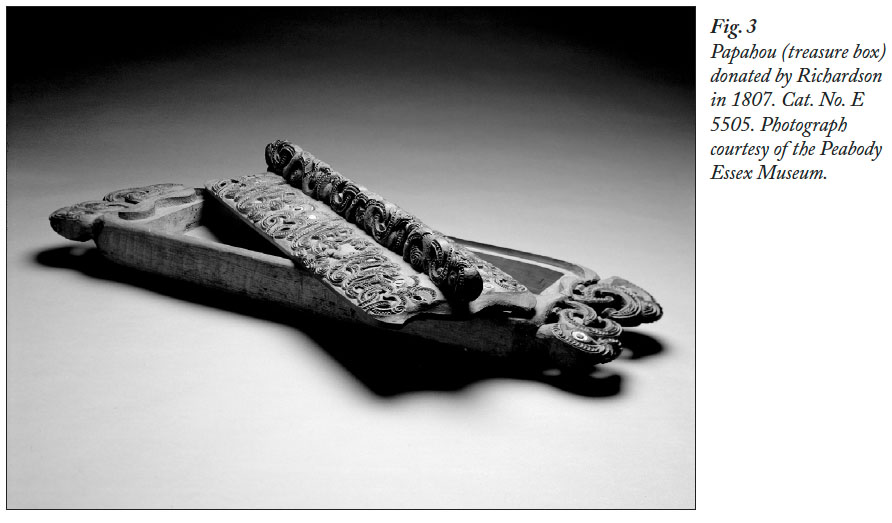 Display large image of Figure 3
Display large image of Figure 37 According to Brown, small treasures (taonga iti), including musical instruments, were often kept inside their owners’ houses or storehouses in a papahou (treasure box) (2003: 46; Fig. 3). A musician might take one of the instruments out of a papahou for a special occasion, either for entertainment or for a spiritual ceremony (Flintoff 2004: 18; Nunns and Thomas 2005: 77). The nguru is a short tube (about 15 cm long) of hollowed wood, intricately carved with sinuous lines and small nodes. A musician would place his mouth against the open curved end, inlaid with paua, and blow to produce a round sound, which he could vary by placing his fingers over the holes in the body of the flute (Flintoff 2004: 72).8 He may also have played the instrument with his nose, breath which, according to Māori tradition, is a manifestation of mauri (life force) (Flintoff 2004: 72).9
8 The pūtōrino is longer (about 40 cm), with a polished slender body that is swollen in the middle and has a carved face with an opening in the shape of a mouth. It is made from a single piece of kauri or totara split in two, hollowed, then bound together again with rows of flax fibre. Traditional stories maintain that the pūtōrino is shaped to resemble the case moth cocoon and that its interior houses the Goddess of Flutes, Raukatauri (Nunns and Thomas 2005: 72). A musician could place his mouth against the end of the flute, or over the carved mouth opening in the centre, and move his fingers across the openings on the body of the flute to produce a male voice, for summoning people to gather, or a quieter female voice for a lament (71). Sometimes the pūtōrino produced unpredictable sounds, such as harmonics, which were considered to carry the voices of Raukatauri and her daughter, Wheke (Flintoff 2004: 74, 101; Nunns and Thomas 2005: 73).
9 A musician may also have recited or sung words into the pūtōrino.10 The flute, according to expert Richard Nunns, “‘bottles up’ the sound, traps it and releases it in a muffled form” (Nunns and Thomas 2005: 74). One traditional song written for the pūtōrino from Tai Tokerau (Northland, including Auckland and areas north), dates back to at least the mid-19th century and is still known in the area today (Gabel 2009: 1). The song describes the narrator rising up and travelling from New Zealand over the Pacific Ocean to the islands of Tonga and Tahiti and the mythological homeland of Hawaiiki (Anderson 1934: 283-84), transporting the narrator (and the listener) to prominent ancestors, events, and places in Tai Tokerau and the Pacific Ocean. Songs such as this one were part of a complex oral tradition that transmitted important information from generation to generation about past migrations across the Pacific, navigating techniques, and ancestors (Hakopa 2011: 149). The song also conveys a different way of imagining the Pacific to the European notion of a vast unconquered territory on the “edge” of the world, measured in a series of lines and grids (Salmond 1997: 170). Rather, it describes the Pacific as a place of connections and crossings between ancestral homes, the gods and the underworld (Matsuda 2006: 763).11 A musician’s performance on the flutes could break down spatial and temporal distance, connecting distant places, ancestors, and gods with the present in a powerful, yet ephemeral way (Fig. 4).
10 The fabric of the nguru and pūtōrino required an intimate engagement between player and instrument. Each flute was unique and carefully carved, its shape determined by its place in Māori cosmogony and its carvings materially incorporating the shapes of the sounds, ancestors, and stories associated with the flutes (Flintoff 2004: 16, 122). Flutes were often carved with a face at the blown end, so that the nose of the flute must be brought to the player’s nose, creating a traditional greeting of sacred breath, known as a hongi. A face could also be carved at the end of the flute, where the breath exits, which was considered the face of the music (Flintoff 2004: 120). This intimate, momentary interaction between musician and flute, in which the lips and nose of subject and object meet, sacred breath flows into and out of the interior of the object, and saliva mingles with wood, can bring about words, ancestors, gods, places, and actions. Throughout this process of mutual involvement between player and flute, both the subject and the object are participants in the course of action (Bruno Latour quoted in Jones and Boivin 2010: 351).
Exchange
11 So how and why were the pūtōrino and nguru removed from New Zealand, and what became of them once they were placed in an entirely different context? While a number of secondary sources record that the Eliza visited New Zealand (see Dodge 1941: 7; Salmond 1997: 528; Brown 2003: 160, for example), the logbook of the Eliza and other primary sources available do not support these statements.
12 The 1805-1807 journey of the Eliza was recorded in a logbook by crewman Philip Payne Pinel.12 Pinel records that Richardson initially followed the favoured Salem trading route around the Cape of Good Hope, stopping to trade in Mauritius. From there, Richardson took the new “easternmost route” to China, sailing around the southern tip of Australia rather than following the well-established route north through the Indian Ocean (Richards 1999: 124). The Eliza reached the new penal colony of Port Jackson (Sydney) in December 1805, where it remained for three months (The Sydney Gazette and New South Wales Advertiser, December 29, 1805; January 5, 1806; and March 2, 1806). In March 1806, Richardson sailed northeast to the Norfolk Islands, where the vessel stopped for ten days before continuing north, visiting Padang in Sumatra, before reaching Canton in September, 1806.13 The logbook ends at that point, but newspaper reports document that the Eliza left Canton three months later, on Christmas Day (Salem Gazette, April 28, 1807). The vessel returned to Salem via an unknown route in late May or early June 1807, with the Pacific objects onboard (Salem Gazette, June 9, 1807).
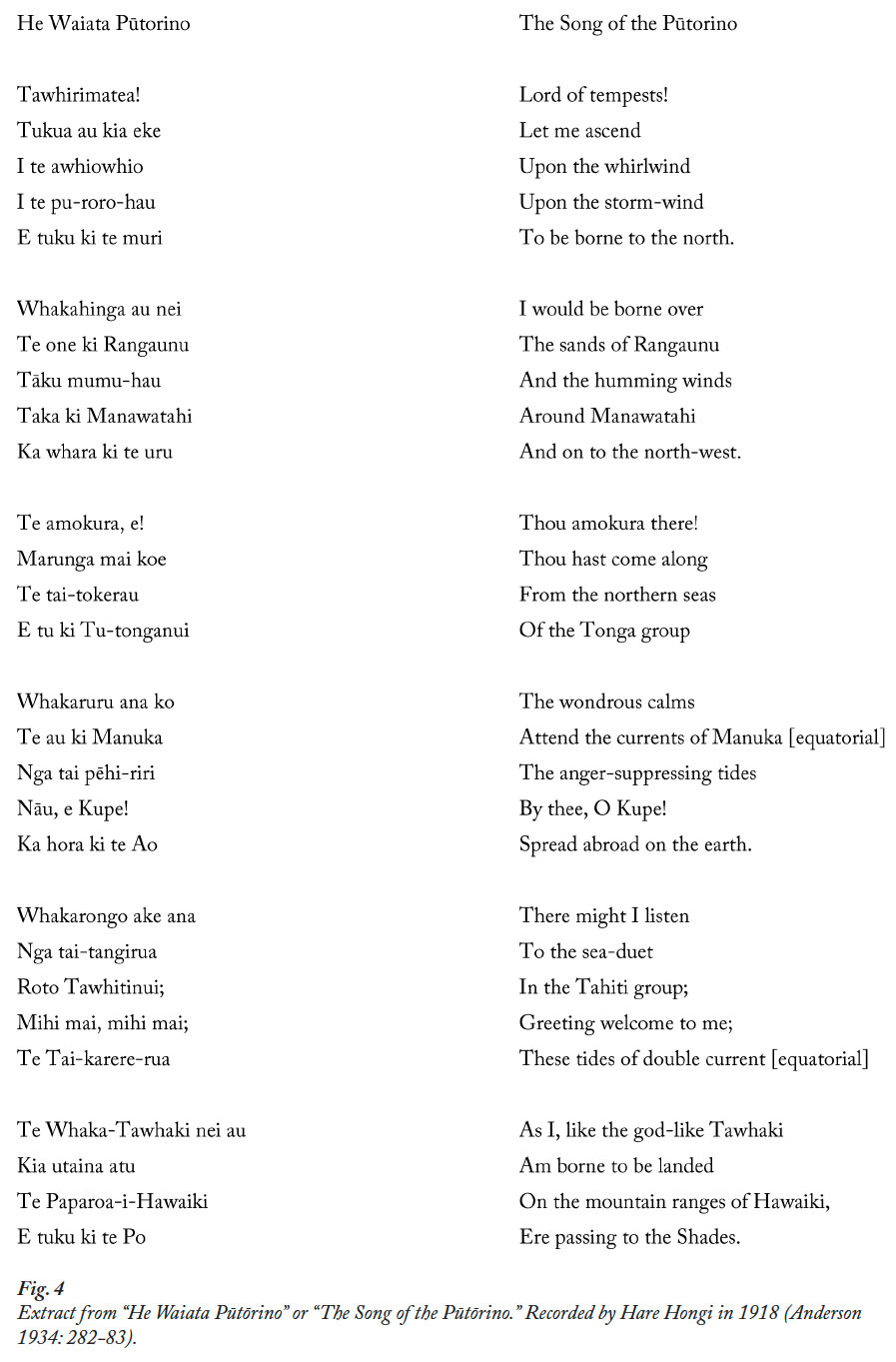 Display large image of Figure 4
Display large image of Figure 4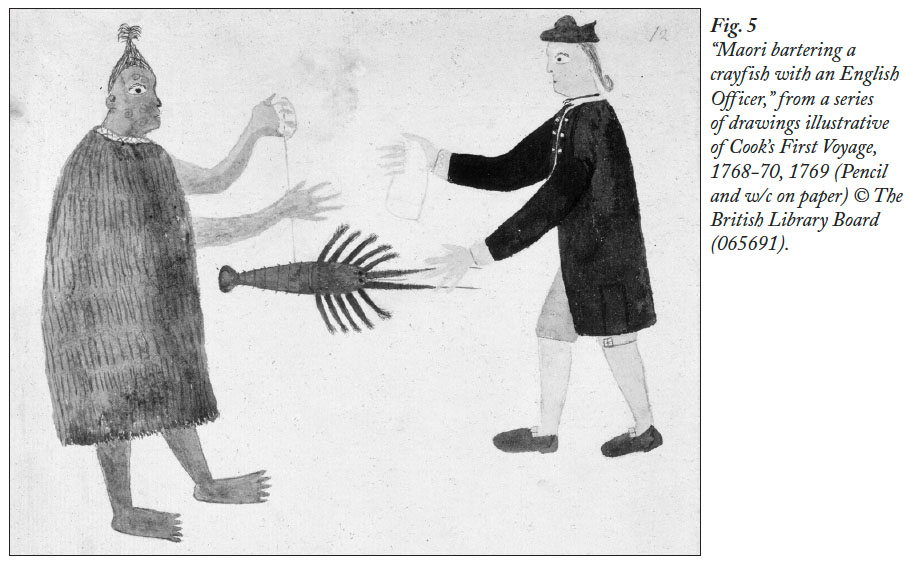 Display large image of Figure 5
Display large image of Figure 513 If Richardson did not visit New Zealand, he must have picked up the large collection from another port. Sydney is a strong possibility, since a steady flow of commercial and trading traffic had begun between Australia and New Zealand in the years prior to the Eliza’s arrival in Sydney in December 1805 (Salmond 1997: 321-32).14 The fact that much of Richardson’s collection (including the flutes) was later incorrectly entered as originating from New South Wales (Australia) in the museum’s accession files also suggests that Richardson acquired the collection in Sydney (Notebook of Donations 1799-1820). Richardson had ample time to collect the artifacts during his three month stay there, where he is recorded as selling six thousand gallons of brandy and Jamaican rum and recruiting ex-convicts as crewmen (The Sydney Gazette and New South Wales Advertiser, March 9,1806).15
14 Scholars often interpret early exchanges between Māori and Europeans as ones in which both parties shared a common understanding of the transaction (see Hooper 2006: 24, for example), but others have pointed out that Māori and Europeans had very different understandings of reality and the way it could materialize during these exchanges (Salmond and Salmond 2010: 7). There is a large and complex body of anthropological literature on systems of exchange, which includes Mauss’s work on Māori gift exchange, The Gift (1990 [1950]), in which he distinguished between gifts and commodities in exchange practices and developed his theory of social obligation that impels reciprocity. Later works sought to dissolve these distinctions by considering the dynamics surrounding objects, including Appadurai’s work (1986) on the circulation of objects, Weiner’s study of “inalienable possessions” (1992), and Thomas’s work on Entangled Objects (1991), in which he argued that “the problem with such unitary conceptions of indigenous economies is that they suppress the entanglement with other systems such as capitalist trade” and that in fact “objects are not what they were made to be but what they become” (1991: 4).
15 Māori had a well-established trading system before the arrival of Europeans, which included exchanging taonga (treasures) between individuals, family groups, and tribes to acknowledge relationships, friendships, and other significant social events. When Europeans began visiting New Zealand regularly in the late 18th century, Māori showed interest in new items on offer that could be incorporated into their own systems (Brown 2003: 35). Initially, they were drawn to iron products, such as nails and knives, that could be sharpened and lashed onto handles and used as chisels or gouges for carving, as an alternative to pounamu (greenstone), which was difficult to obtain (35). In exchange for European goods, Māori offered food, words, dances, or taonga (Hooper 2006: 44).
16 The gift of taonga, as the manifestation of ancestors and the power and prestige of a lineage, generated a relationship between the parties, and between the lineages of the parties, with an expectation of ongoing reciprocity across the generations (Henare, Holbradd, and Wastell 2007: 60). According to Anne Salmond, these cycles of reciprocity produced “constant movement in the network of cosmic relations” that ordered the Māori world (1997: 177). So while the transaction may have removed the nguru and pūtōrino from New Zealand physically, for Māori it did not signify the end of the relationship between the two parties. Rather, it signalled the beginning of an ongoing relationship, generating ties across territorial and cultural boundaries (Henare 2007: 56-60; 2005: 7). The object stitched the parties together, then and in the future (Fig.5).
17 Since we do not know the circumstances of the initial exchange of the flutes between Māori and Europeans, we cannot understand the specifics of the relationship generated between the two parties. There is a strong possibility, however, that the artifacts were traded with whalers, who were regularly visiting the Bay of Islands in the first few years of the 19th century (Salmond 1997: 321). Whalers, like traders, tended to be “casual collectors,” preferring small, portable, carefully carved and rare artifacts (Hooper 2006: 61; Dodge and Copeland 1949: 3; Flintoff 2004: 17; Richards and Richards 2000: 7). The flutes fitted the criteria perfectly.
18 When Richardson selected the flutes for his collection, he no doubt took into account the factors outlined above, but he must also have had a different kind of mobility in mind. Richardson was a founding member of the exclusive East India Marine Society, established in 1799 for the few captains and supercargoes who had travelled beyond Cape Horn and the Cape of Good Hope (Peabody Museum of Salem 1916: 2).16 The Society functioned as a support organization and an information repository and included a “Museum of natural and artificial curiosities particularly such as are to be found beyond the Cape of Good Hope and Cape Horn” (2).
19 The Museum’s early collections were defined by mariners such as Richardson, who travelled to distant and unknown places searching for economic opportunities.17 Like other early museums in America, the East India Marine Society museum emerged from the European tradition of personal cabinets and was closely linked with late 18th-century Enlightenment practices of collecting and categorizing things in the name of science and reason (Grimes 2003: 17-18). These practices were also related to control, wealth, and power; at the annual banquet of the Society in 1804, six months before Richardson set out on his journey, a toast was made to “A Cabinet: That every mariner may possess the history of the world” (Lindgren 1995: 184).
20 Alexis de Tocqueville, who visited the U.S. in 1831, noted that the economic and social mobility he observed in hyper-commercial postRevolutionary America, was accompanied by a physical restlessness in its citizens. De Tocqueville described American men as: “[a]lways in motion, they could not relax, for they did not know for certain where they were and where they soon would be financially and socially.... Life in a condition of equality seemed always in flux, always anxious” (quoted in Takaki 1978: 73). De Tocqueville’s observation aptly describes the Society’s founders such as Richardson, whom former Peabody curator John Grimes has described as America’s first global entrepreneurs (2003: 17).
21 Richardson was the son of a Revolutionary Soldier and came from a long family tradition of mariners, many of whom died at sea.18 He was clearly a hardworking and successful mariner, having worked as a shipmaster for ten years on voyages around the world by the time he took charge of the Eliza at age thirty-six (Osgood and Batcheldor 1879: 147, 193). His hardiness and determination come across in one of his letters to his father written during a trading voyage from Havana to Salem the year before the Eliza voyage:
For Richardson, the objects served as proof that he was a man of the Enlightenment, of commerce and of independence, all virtues that helped Salem men move along their life course from mate to supercargo to captain and, finally, to merchant (Ruffin 2008: 154).
Flux
22 Before the flutes reached Salem, they paused for a year or more onboard the Eliza, as the vessel crossed vast distances, weaving in and out of different worlds. Goods collected during the journey were stored in boxes, crates, barrels, and chests in the cargo hold, a giant cavity at the bottom of the ship. Down in the hold there was a world of things, gathered together from distant places and cultures that had never before interacted, constantly moving and knocking against each other with the motion of the waves. These things were out of place and on the loose, disconnected from their original context, but not yet in the European world of scientific classifications. Among the fur skins, tea, porcelain, satin, handkerchiefs, and nankeens purchased along the way, lay Richardson’s collection of “curiosities” (Salem Gazette, June 11, 1807; Pinel, June 3, 1806). Like many Salem captains, Richardson had his own trading stock, which he sold privately once he returned to Salem (Salem Gazette, June 12, 1807). I imagine the flutes down in the hold slotted in among Richardson’s “100 tea sets of assorted China, handsome figures,” or slipped between the layers of handkerchiefs or yellow nankeens that would soon be cut into jackets or trousers, or placed in the “chest of 30 yard piece black satin,” or folded into the soft, smooth, fine Chinese silk destined to be sold to Salem’s wealthy elite (Salem Gazette, June 12, 1807).
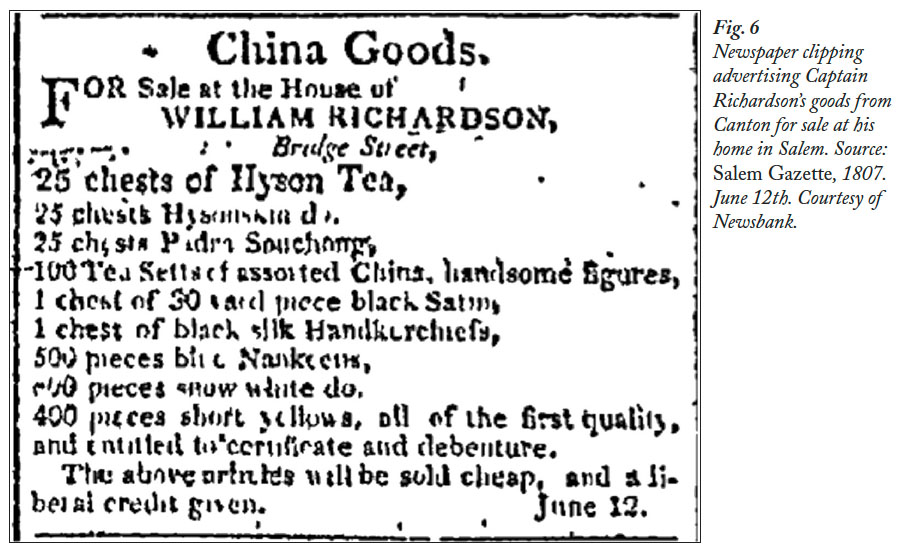 Display large image of Figure 6
Display large image of Figure 623 The Eliza was a borderland of sorts, a mobile intermediate space or contact node where different cultures and systems of value came into contact.19 In some ways, it was a space of global commercial seagoing trade, governed by its own calculated kind of knowledge, where objects such as the flutes, enveloped by commercial goods in the hold and beneath the feet of the crew, were in the process of being assembled, quarantined, and redefined under the banner of the expanding Salem empire (Fig. 6).20
24 But things were also regularly taken out of the hold. The crew repeatedly unloaded, reloaded, and rearranged the goods as the ship traded around the world, interacting with them in a very tactile way. “All hands employed breaking out the cargo and storing ... it again,” Pinel noted on board the Eliza, after a couple of months at sea (Pinel, July 4, 1805). “Employ’d in overhauling the Skins – found them greatly damaged by the Storms” he recorded later in the journey (June 3, 1806). While crew members usually handled things in the hold for commercial reasons, Pinel’s journal shows this was not always the case: “Second officer being in the hole found a Brandy pipe which was stored under the main hatch way both heads of which fell in and all the liquor out” (October 2, 1805).
25 What would Richardson and his crewmembers have made of the Māori objects on board the Eliza? Richardson was born in 1769, the same year that Captain Cook made the first European landing in New Zealand, and he came of age just as New Zealand was taking shape in the European imagination (Vinton 1876: 591). The Salem and Boston newspapers of the time featured extracts from the journals of European visitors to New Zealand, mused about the commercial potential of New Zealand flax and featured reports, often inaccurate, about European voyages to the area.21 These early European voyages established an enduring vision of the Pacific, elucidated in Bernard Smith’s seminal work (1960), and summarized by Matt Matsuda as “a space of paradisiacal idylls, of exoticism, sexuality, and savagery, of escape, or of transit to better things – the fabulous mysteries and wealth of Asia and India” (2006: 772). Ideas of race were also being played out closer to home, where Americans had built a shared identity as “white people” prior to the Revolution and in the early 19th century were beginning to build a “New World” master narrative that included replacing the “uncivilized” American Indians with the modern and “civilized” order of culture, science, and reason (O’Brien 2010: xxi, 5).
26 Could Richardson, raised during the “Age of Reason,” with a Christian background and a head for commerce, have looked at the flutes and seen something beyond “curiosities” from a “savage” country, something more than souvenirs of Salem’s expanding empire? Henare, Holbraad, and Wastell have noted that in important respects the concepts instantiated by the Polynesian artifacts of these early exchanges are untranslatable and incommensurable, but they also argue that things can conjure the outlines of a different, incomprehensible world if they are approached with an attitude of conceptual creativity (2007: 12-16).22 Perhaps the most a trader like Richardson could do was to employ the familiar enlightenment tropes when engaging with non-Western objects, viewing them as objects of superstition and ignorance.23 But, at the very least, Smith points out, these early European voyagers contributed to “a contradictory process set in motion by those strange artifacts brought back by the voyagers,” one that led to the development of European appreciation of non-mimetic art in the 20th century (1960: 109).
Abeyance
27 The Eliza sailed into Salem Harbor in June 1807, after two years at sea, and docked at one of the dozens of wharfs. Amid the cacophony customs officials inspected, unloaded, counted, weighed, and documented the cargo, calculating the amount of duty owing to the American government (Frayler 2003: 6-7; National Park Service 2000: 5). Richardson, having completed another successful trading voyage, took his portion of the goods home. But the goods and artifacts did not facilitate the social mobility that Richardson might have hoped for. The hardy, enterprising captain was stopped short. He died six months after returning home, from a “long, distressing illness” (possibly contracted during his journey), leaving his wife pregnant with their eleventh child (Salem Gazette, December 11, 1807). In his death notice he is described as “the tender and affectionate husband and indulgent parent; the active and obliging friend; the enterprising, industrious and honorable citizen” (Salem Gazette, December 11, 1807).
28 Before he died, Richardson donated the artifacts to East India Marine Society (Notebook of Donations 1799-1820). The Society recorded them as artifacts from New South Wales in Australia, Nootka Sound in Canada, and New Zealand.24 Although many, though not all, the artifacts did originate from these places, most of them were mislabelled, including the musical instruments, which were noted as coming from New South Wales, as well as the treasure box, which was recorded as being from Nootka Sound, New Zealand (Notebook of Donations 1799-1820). Such mislabelling of ethnographical objects was not uncommon in museums at this time, when objects were usually documented less systematically than natural specimens (Hooper 2006: 67; Fig. 7).
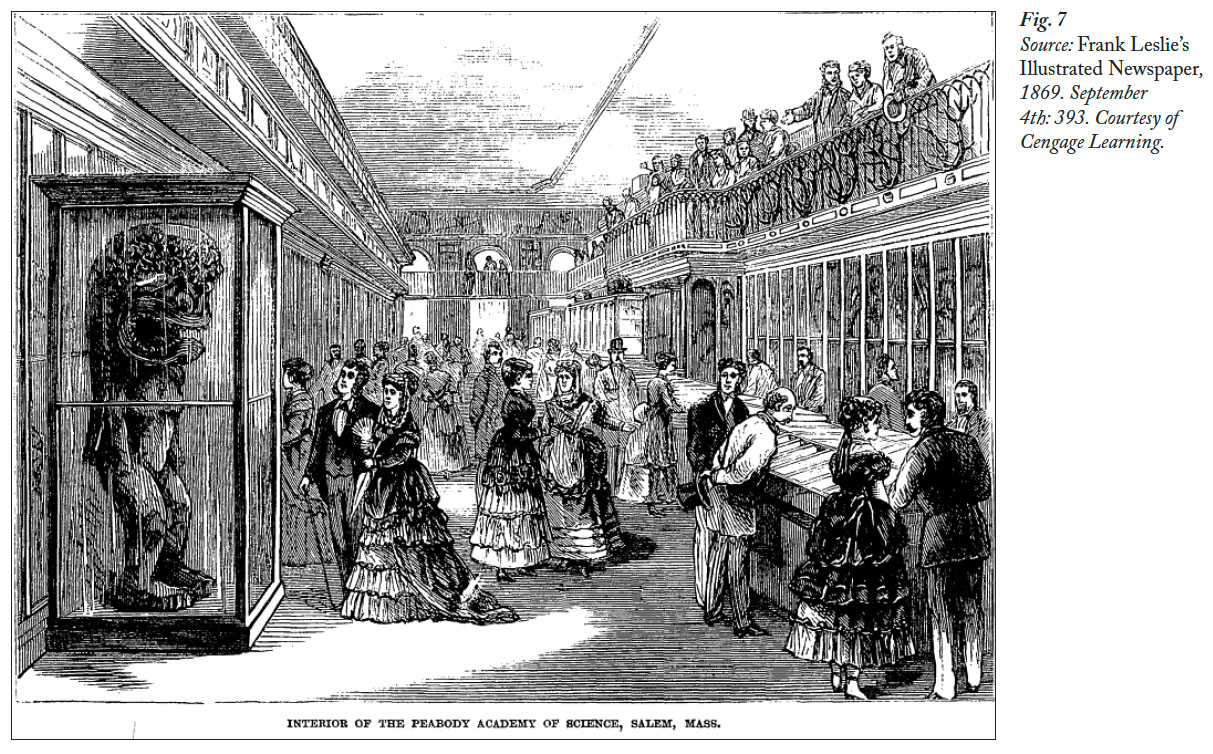 Display large image of Figure 7
Display large image of Figure 729 From 1824, the flutes were displayed in one of the tall curiosity cabinets that lined East India Hall, a large room that contained all the Society’s objects from China, the East Indies, and Oceania (Lindgren 1995: 194). The displays emphasized entertainment rather than education, reflecting the emerging 19th-century European and American fascination with vision and spectacle, in which other places were continually constructed as objects for display or exhibition, and spectators were encouraged to perceive the rest of the world as an extended exhibition (McAlister 2001: 16-17). The museum was enormously popular with locals and tourists, who variously described it as “whimsical,” “wonderful,” and a “fairy land” (Lindgren 1995: 198). Members of the Society accompanied visitors through the hall, telling stories about the objects and places they had visited, remembering and reinventing the world, while the visitors became virtual tourists, inventing the world through the objects and narratives.
30 During the 19th century, the objects were organized by type and later by function, rather than by geography, an arrangement that displaced and homogenized these complex artifacts (Wagelie 2007: 29). Together, the objects presented a powerful collection of the exotic “other,” in which distant places were displayed as inferior and uncivilized as a means of legitimizing and celebrating imperialism (Lindgren 1995: 200). While the Asian objects included tea sets and furniture, depicting a luxurious and wealthy “other,” the Oceanic objects included a disproportionate number of war weapons, reinforcing stereotypes of Oceanic cultures as savage and grotesque (Kuo 1930: 440-41; Lindgren 1995: 185). A daring visitor could even lift a cloth to view a hidden tattooed Māori head (Lindgren 1995: 195).
Revitalization
31 At the end of the 19th century, the Oceanic collection at the Peabody Museum (as the East India Marine Society was known by then) was rearranged into geographical groups, as the focus of display moved more toward education (Wagelie 2007: 29). The new arrangement prominently featured the nguru and pūtōrino as well as other Māori objects, and also incorporated historic photographs and portraits of Māori (29- 30). This shift in emphasis toward the original context of the objects reflected the wider growth of American ethnographic folklore studies at the end of the 19th century and the corresponding interest in temporal and cultural relativism (Retman 2011:8).
32 In the 1940s, Ernest Dodge and Edwin Brewster, Peabody curator and acoustic specialist respectively, picked up the flutes, placed them against their lips and breathed into them. Dodge and Brewster wanted to work out how to play the instruments, but it was no easy task: “the nguru, like the pūtōrino, offers a problem that is thus far unsolved.... Sounding ... is a long-forgotten art. All that anybody can do now is to make the best guesses he can concerning both” (1945: 56). By then, traditional Māori musical instruments had become scarce and many of the playing techniques had been lost, following discouragement by missionaries and teachers in New Zealand throughout the 19th century (Flintoff 2004: 17).
33 Dodge and Brewster, searching for “authenticity” in the flutes, conducted considerable research, drawing on a small but growing body of research into Māori instruments in New Zealand, examining Māori depictions of the flutes in carving, and analyzing early European observations. They concluded that the flutes were objects of art, enthusing that “the nguru, laboriously drilled, carefully shaped, elaborately ornamented, is, like the pūtōrino, unique in all the world, found nowhere outside New Zealand” (1945: 60).
34 As well as engaging intellectually with the flutes, the men also made close physical contact with them in their effort to make them “play.” Their description of the “lip-fipple” method conveys the physical intimacy and intricacy required: The
The men practised in front of a mirror, observing their attempts to perform the past (45).
35 Their efforts were rewarded when they managed, with difficulty, to produce sound from the flutes, probably for the first time since the instruments had left New Zealand. In doing so, Dodge and Brewster generated a distinctive medium of material culture, one that Georgina Born describes as “an extraordinarily diffuse kind of cultural object” that constantly moves between different planes of sociality and intimately mediates between player and instrument, transforming those who engage with it (2011: 376-78).
36 Over the last thirty years, New Zealand musicians and carvers have experimented with Māori flutes in museums around the world as part of a “revival” of traditional Māori music that has accompanied a resurgence of Māori cultural identity (Royal 2009: 6). Leaders of this movement, including Hirini Melbourne, Richard Nunns and instrument makers such as Brian Flintoff, have examined, played, recorded, and composed with Māori traditional instruments from museums (Flintoff 2004: 8-9).25 New Zealand composer and researcher, Charles Royal, has noted that work on mōteatea (traditional Māori song poetry) focused for many years on recording and preserving existing traditional songs, but that more recently activity has turned toward composing new songs, based on a thorough grounding of the styles of the tradition (Royal 2009:6; Fig. 8).
37 According to Wonu Veys, these musicians and researchers have literally blown new life into the instruments (2006: 123). Performing with taongapūoro (singing treasures) from museums activates several planes of social mediation. For Māori, it can reanimate a kin group’s ancestral landscape and allow descendants to re-live the events of past generations, as well encouraging new creative encounters with the instruments (Tapsell quoted in Hernare, Holbraad and Wastell 2007: 57-58). The process of gaining physical access to the flutes has initiated ongoing relationships between museums and members of the Māori community. The live performances and recordings have generated imagined communities that experience the sound of the flutes as part of New Zealand’s unique soundscape and collective identity (Born 2011: 378). And the performances reconfigure spatial proximities, producing “public intimacies” between the instrument, the musician and the audience (Guilbault quoted in Born 2011: 380).
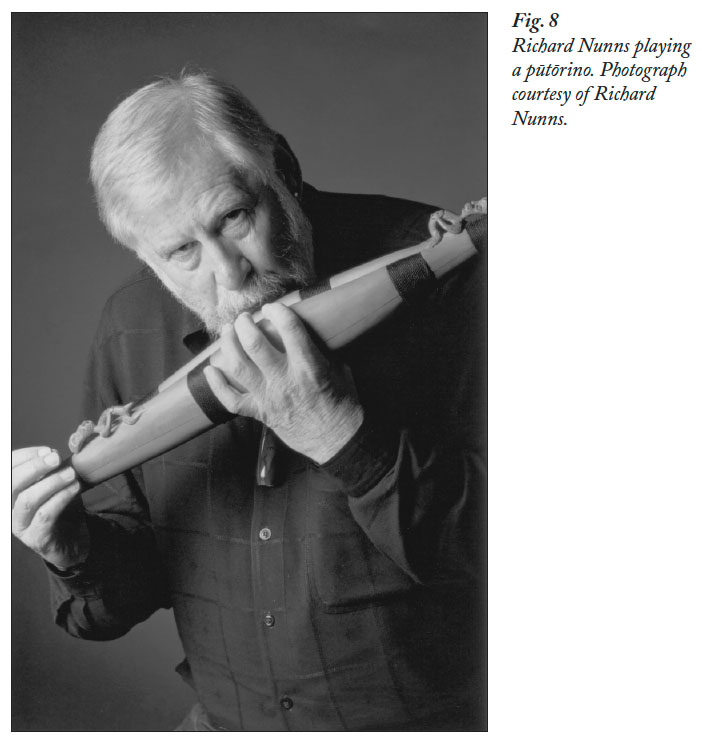 Display large image of Figure 8
Display large image of Figure 838 So while museums may have limited the spatial mobility of these traditional Māori instruments (Henare 2005: 9), the flutes have continued to do “work,” collapsing time and space, forging relationships between cultures, encouraging creativity, gathering audiences and encouraging an entanglement between person and object. As far as we know, no one has played the nguru and pūtōrino since Dodge and Brewster picked them up in the 1940s, but the musical sound object generated during the recent revival of traditional Māori instrument experts allows us to project our associations with the music back into the Peabody flutes, continuing the process of bringing them to life (Born 2011: 377).
39 While for Māori, certain things have always had power and efficacy (in that they can do things, they don’t just signify things or mean things), European scholars have long debated the possibilities and limits of material agency. In The Gift (1954), Mauss argued that material things, including taonga, were in some ways person-like. Scholars have since debated the work of Mauss and others, including Strathern (1988) and Wagner (1991), who wrote about the “distributed personhood” of bodily substances and other material extensions of the body; Gell (1998), who argued that objects could “act” as social agents, exercising secondary agency; and Latour (2007), who questioned the distinction between things and people, arguing that they are in fact enfolded into one another. Recently, scholars from various disciplines have sought to move beyond the dualistic and dialectical approaches in material culture to give methodological attentiveness to things ( Jones and Boivin 2010: 348). Robin Bernstein (2011), for example, has written about “scriptive things” that can script meaningful bodily behaviours; Karen Barad (2007) has conceptualized matter as a doing, rather than a thing; and Henare, Holbraad, and Wastell have argued that things, rather than serving merely to illustrate the social system, can in fact enunciate different ontological “worlds” or “natures” (2007: 10).
Conclusion
40 While the conservation of objects in museums allows us to study, admire, and celebrate them, sometimes, in the quiet space of the museum gallery, objects behind the glass can seem removed from us and appear as beautiful but static, finished products. It can be difficult to imagine the “life” of something before it became part of a museum collection. As archaeologist Michael Shanks has said, “We can forget that objects haunt. We can fail to feel the ghosts” (1998: 16). But the nguru and pūtōrino encourage conceptual creation and occupy a space that resonates beyond their small size, a presence captured in Bachelard’s phrase, “intimate immensity,” in which matter can “achieve conquest of its space, its power of expansion over and beyond the surfaces by means of which a geometrician would like to define it” (1969: 202-203).
41 The flutes are objects in motion on a number of levels, each demonstrating their ongoing dynamism. They are part of a transnational and oceanic flow of objects, commodities, people, and ideas between Europeans and Polynesians that began in the 18th century and continues today. They move across and weave between value systems, as taonga or treasures, as gifts, curiosities, and as art. They encourage intimate movements and entanglements between musician and flute, subject and object, and idea and thing. And they produce music that moves across several planes, creating shapes in the space, carrying the voices of ancestors, distributing materially into the carvings of the flutes, encouraging public intimacies and generating imagined communities of collective identity. All of these movements, circuits, and entanglements are harboured in the small, yet infinite, frames of the Māori flutes in the Peabody Essex Museum.
(Bachelard 1969: 190)